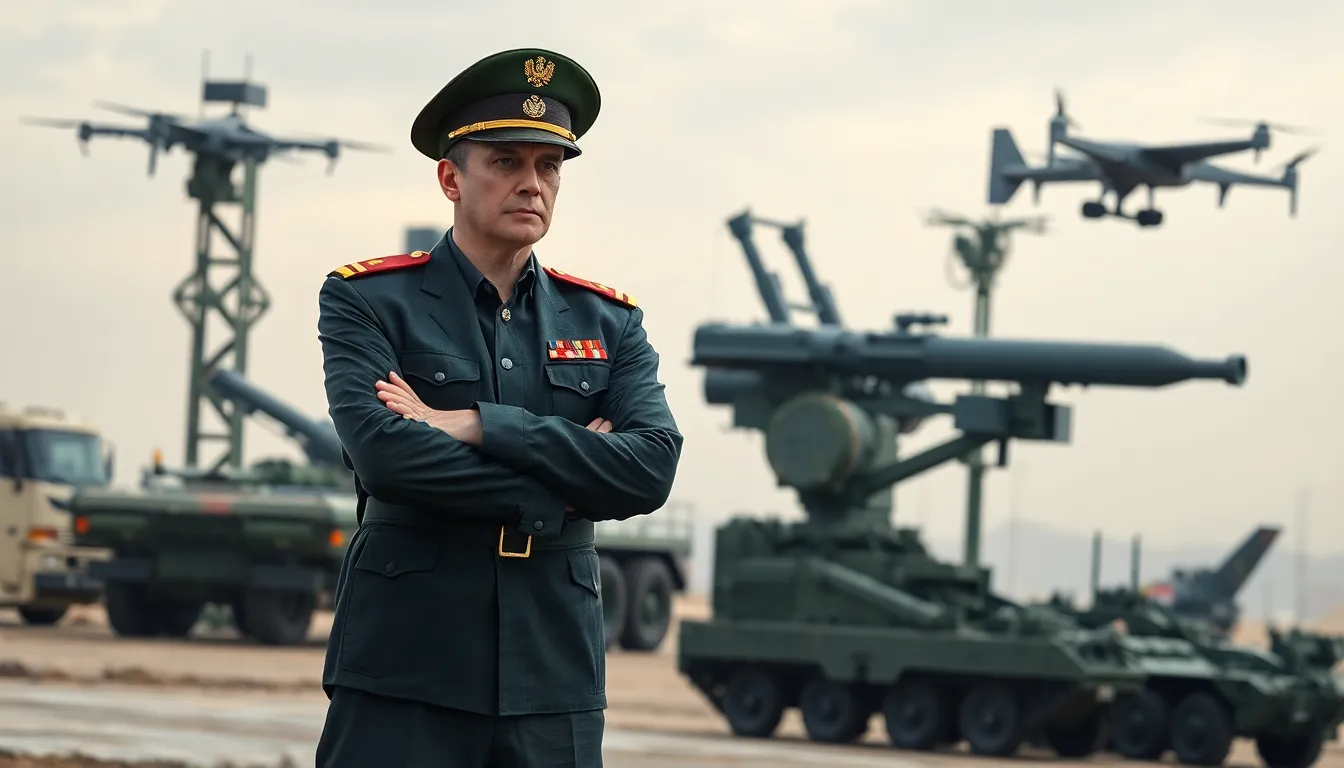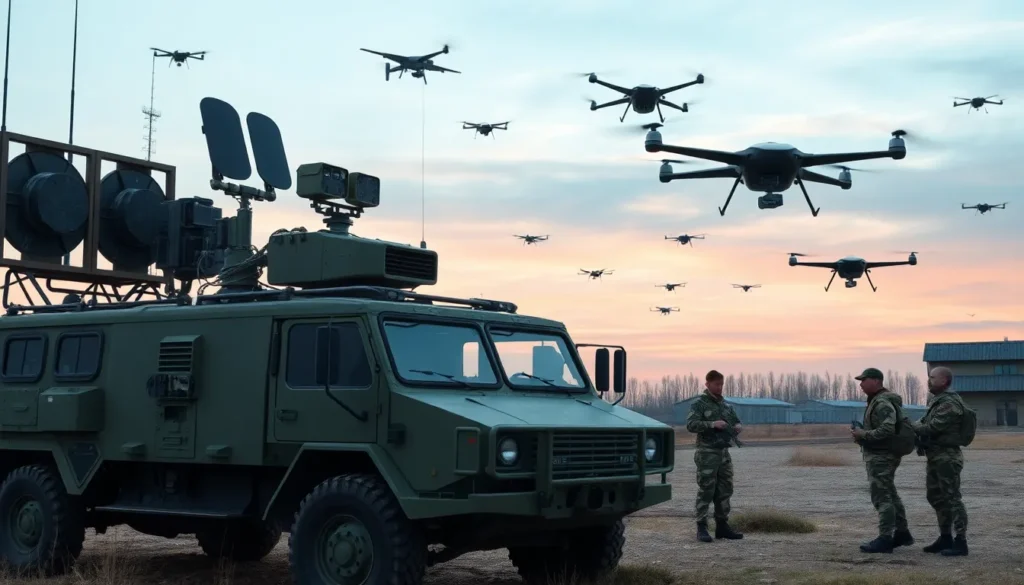In recent months, drone warfare has emerged as a pivotal aspect of modern conflicts, reshaping military strategies worldwide. Russia’s response to drone attacks highlights its evolving approach to aerial threats, revealing both tactical adaptations and geopolitical implications. As drone technology advances, nations grapple with the challenge of defending their airspace against these increasingly sophisticated weapons.
The Kremlin’s reaction to recent drone incursions underscores a blend of military readiness and strategic communication. By analyzing Russia’s countermeasures and public statements, one can gain insights into its broader defense posture and intentions on the global stage. Understanding these dynamics is crucial as they not only impact regional security but also influence international relations amid rising tensions.
Table of Contents
ToggleOverview of Drone Attacks
Drone attacks have emerged as a pivotal element in contemporary warfare, significantly altering operational tactics and strategic frameworks. Nations deploy unmanned aerial vehicles (UAVs) for various purposes, including surveillance, intelligence gathering, and targeted strikes. The ease of access to drone technology has democratized its use across state and non-state actors, contributing to rising incidents globally.
Many conflict zones report an increase in drone usage over the past few years. For example, in 2022, over 20 countries utilized drones in military operations, underscoring their strategic importance. Drones’ low operational costs and versatility make them attractive to armed forces and insurgent groups alike.
The effectiveness of drone strikes often generates mixed responses. While they can achieve precision targeting, collateral damage remains a major concern. Reports reveal that up to 30% of drone attacks may result in civilian casualties, creating both humanitarian and political challenges for states involved.
Russia has strategically adjusted its military doctrine to address the growing threat posed by drone attacks. The nation invests in counter-drone systems, including electronic warfare technologies designed to disrupt UAV operations. As a result, understanding this evolving landscape of drone use highlights its implications for international security and defense policymaking.
Russian Military Strategies

Russia’s military strategies focus on adapting to the evolving landscape of drone warfare. The response includes both preemptive measures and advanced defense systems to counteract drone threats.
Preemptive Measures
Russia employs preemptive measures to diminish the effectiveness of drone attacks. These measures include intelligence gathering, targeting drone launch sites, and disrupting supply chains linked to drone operations. For instance, surveillance operations monitor suspected drone activity, allowing Russian forces to conduct strikes against known launch points. Moreover, collaboration with allied nations enhances information-sharing and coordination, resulting in a more robust preemptive stance.
Defense Systems Employed
Russia utilizes various defense systems to tackle aerial threats posed by drones. Notable systems include:
- Pantsir-S1: A combined short-range surface-to-air missile and anti-aircraft artillery system designed to intercept drones and other aerial threats.
- S-400: A long-range air defense system capable of detecting and engaging a wide range of aerial targets, including drones.
- Electronic Warfare Units: These units disrupt drone communications and navigation systems, rendering the drones ineffective during operations.
The integration of these defense systems into military strategies demonstrates Russia’s commitment to maintaining air sovereignty and mitigating the impacts of drone warfare on its defense capabilities.
Political Reactions
Political reactions to drone attacks in Russia reveal a complex interplay between government statements and public sentiment, both reflecting the nation’s posture in light of evolving security threats. The Kremlin’s response demonstrates both an urgency to assure national security and a desire to control the narrative surrounding military engagements.
Government Statements
Government statements emphasize a resolute stance against drone incursions. Russian officials frequently assert that drone attacks threaten national sovereignty, prompting increased military vigilance. Statements from the Ministry of Defense underline ongoing investments in counter-drone systems, which they characterize as essential for protecting critical infrastructure. High-ranking officials declare that the use of drones by adversaries necessitates an immediate and robust military response, often referencing specific incidents to highlight the urgency of enhanced defensive measures. Furthermore, the Kremlin often links drone attacks to broader geopolitical conflicts, framing them as attempts to destabilize the region and undermine Russia’s influence.
Public Sentiment
Public sentiment regarding drone attacks is characterized by a mix of fear and national pride. Many citizens express concern over the potential for civilian casualties and broader military escalation. Reports indicate that public opinion shifts based on the media coverage and government rhetoric surrounding such attacks. While some view the military’s response as necessary for national security, others question the efficacy of current strategies, advocating for diplomatic solutions instead. Social media platforms serve as a barometer for public sentiment, where discussions about military actions and government responses often reflect a desire for transparency and accountability in addressing drone threats.
International Implications
Russia’s response to drone attacks extends beyond its borders, influencing relationships with other nations and the overall landscape of global security. The strategic recalibrations within Russia’s military posture resonate with international stakeholders, shaping geopolitical dynamics.
Relations with Other Countries
Russia’s military adaptations in response to drone attacks affect its relationships with both allies and adversaries. Russia strengthens partnerships with countries like Iran and China, collaborating on drone technology development and counter-drone systems. Additionally, military exercises involving drone warfare have become common among allied nations, promoting interoperability and collective security measures.
Conversely, Russia’s countermeasures instigate concerns among neighboring countries, particularly in Eastern Europe. Nations such as Ukraine perceive Russian drone capabilities as an escalating threat, heightening regional tensions. Reactions from NATO member states underscore the urgency for enhanced air defense systems and joint military collaboration to counter potential Russian aggression.
Impact on Global Security
The rise of drone technology and Russia’s tactical adaptations significantly influence global security dynamics. With over 20 countries employing drones in military operations, the potential for miscalculation and escalation increases, especially in conflict zones. Russia’s investment in electronic warfare and anti-drone technologies sets a precedent for other nations, prompting arms races in drone capabilities.
Furthermore, the proliferation of drone warfare raises ethical concerns about civilian safety and the legality of military actions. Reports indicate that drone strikes sometimes lead to collateral damage, complicating international legal frameworks surrounding warfare. As states evaluate their military strategies, the challenges of countering drone threats demand global cooperation and comprehensive regulation to ensure security while minimizing civilian harm.
Future Outlook
Russia’s response to drone attacks signals a shift in military strategy and geopolitical posture. Anticipating further developments in drone warfare will shape its future defense initiatives.
Expected Developments
Increased investments in counter-drone technology are anticipated as Russia seeks to enhance its military capabilities. Deployment of advanced radar systems and artificial intelligence will likely bolster detection and interception of drone threats. Russia may engage in developing drone countermeasures that utilize electronic warfare, aiming to disrupt enemy drone communications and navigation systems effectively. Heightened military exercises focusing on drone scenarios could also become prevalent, enabling forces to adapt rapidly to evolving tactics. Furthermore, the Kremlin’s partnerships with drone-manufacturing nations like Iran might lead to collaborative advancements in drone technology, presenting challenges to adversaries in conflict regions.
Long-term Strategies
Long-term strategies for Russia will revolve around redefining its military doctrine to include a robust counter-drone framework. This adaptation may involve strategic shifts in basing and mobilizing rapid response units for unexpected drone incursions. Continued investment in research and development will ensure that Russia maintains technological superiority in drone warfare. Expansion of intelligence-gathering operations, including satellite reconnaissance, will likely support preemptive strikes against drone launch sites. Furthermore, fostering regional alliances focused on shared security threats from drone technologies may bolster Russia’s defense posture. Establishing regulatory measures for drone use in military operations may also become an essential part of maintaining state sovereignty while addressing international ethical concerns surrounding civilian safety.
Russia’s response to drone attacks marks a pivotal shift in its military strategy and geopolitical stance. By investing in advanced counter-drone systems and adapting its military doctrine, the Kremlin demonstrates a commitment to maintaining air sovereignty. This evolving landscape of drone warfare not only influences Russia’s defense capabilities but also reshapes its relationships with other nations.
As drone technology continues to proliferate, the potential for conflict escalation grows, highlighting the need for international cooperation and regulation. The complexities of public sentiment and government responses further illustrate the challenges Russia faces in navigating this new era of warfare. Ultimately, how Russia addresses these challenges will significantly impact global security dynamics moving forward.





